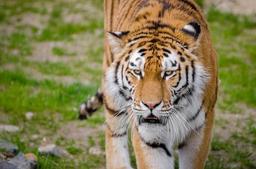
Learning Module #1-Animal Behaviors and Characteristics
Quiz by Sarah Wilson
Feel free to use or edit a copy
includes Teacher and Student dashboards
Measure skillsfrom any curriculum
Measure skills
from any curriculum
Tag the questions with any skills you have. Your dashboard will track each student's mastery of each skill.
With a free account, teachers can
- edit the questions
- save a copy for later
- start a class game
- automatically assign follow-up activities based on students’ scores
- assign as homework
- share a link with colleagues
- print as a bubble sheet
15 questions
Show answers
- Q1A whale knowing how to swim right after birth is an example of a(n)learned behaviorinnate behaviorterritorial behaviorsurvival behavior30s
- Q2Some animals, like a peacock, use their bright colors to attract a mate. This is known ascourtshipestivationpheromonesmigration30s
- Q3Ants leaving a scent trail, a dog urinating, and a skunk spraying are all examples ofestivationpheromonescamouflagecourtship30s
- Q4A butterfly can be divided into two equal parts. This is known aslateral symmetrybilateral symmetryradial symmetryno symmetry30s
- Q5Poison dart frogs are brightly colored so that they can warn predators that they are poisonous...this is an example ofcircadian rhythmwarning colorationhiberationcamoflauge30s
- Q6A seastar can be divided into many equal parts around a central point. This is known asbiradial symmetrybilateral symmetryno symmetryradial symmetry30s
- Q7Bats are active at night and deer are active during the day. This is an example ofcircadian rhythmpheromoneslearned behaviorestivation30s
- Q8Frogs burrow into the mud during the hot summer to cool off. This is an example ofestivationcommunicationmigrationhiberation30s
- Q9Birds flying south and butterflies traveling to Mexico are both examples ofhibernationmigrationpheromonesestivation30s
- Q10Animals blending in with their environment is known ascamoflaugeestivationwarning colorationcommunication30s
- Q11Which of the following is not a characteristic of all animals?producerconsumereukaryoticmulticellular30s
- Q12Going in active along with decreased body temperature in the Winter is known ascommunicationhibernationestivationmigration30s
- Q13Which of the following is true of all animals?unicellularcell wallno cell wallprokaryotic30s
- Q14A lion hunting and a bird flying are examples of a(n)innate behaviorbody languagelearned behaviorcommunication30s
- Q15Migration, Estivation, and Hibernation are all examples ofbody languagelearned behaviorssurvival behaviorsseasonal behaviors30s